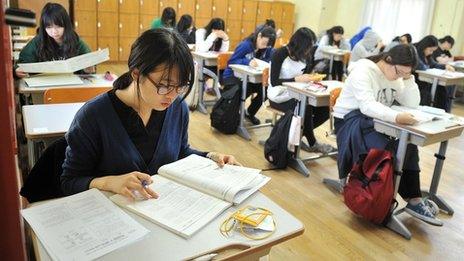Take-away Pisa for busy people
- Published

The top places are taken by Asian school systems
What are these Pisa tests?
Not keen on browsing 500+ pages of education test results? Reluctant to look at more tables than an Ikea factory....
Here's the short-attention span version.
Teenagers around the world take these tests, but it's education ministers who feel the heat.
Because these two-hour tests in maths, reading and science, taken by 500,000 15-year-old pupils, are used to create international league tables, comparing standards in different countries. Individual pupils don't get results, it's education systems.
The latest rankings run from Shanghai at the top to Peru at the bottom. The gap in scores between top and bottom is equivalent to six years of learning.
If you think you can do better you can try the test yourself, external.
The tests are run by the Organisation for Economic Co-operation and Development in Paris. The "Pisa" name stands for the Programme for International Student Assessment, a name chosen so that the acronym spells the same in English as in French. Unlike the OECD.
It's not just countries taking part. It also includes regional administrations, like Shanghai, which is bigger than most European countries. Although for the next tests in 2015 there will be a wider entry from more Chinese provinces.
Key points from 2012 tests
The table-topping Asian education systems, such as Shanghai, Singapore and Hong Kong, are not just beating everyone else, they are accelerating further ahead.
Vietnam has a higher standard of education than the United States. Think how unlikely that once would have seemed. Think of the turn of history's wheel.
South Korea's children are the least happy at school, as well as being among the highest achievers.
The happiest schoolchildren, according to data gathered alongside the tests, are in Indonesia and Peru. These have among the worst results in the world.
The UK's results have failed to show any real sign of movement and are flat-lining. Think of all those announcements, the interventions, the investment, the speeches.
Wales has worse results than the rest of the UK.
If the US state of Massachusetts had been ranked like a separate country it would be one of the best in the world. The mediocre US national score conceals a wide divergence between states.
There is a spectacular north-south divide in Italy. The Veneto region in the north is a world beater, while Calabria in the south is rubbing shoulders with Kazakhstan.
Finns are not what they used to be. Finland has slipped from its education pedestal and is no longer in the top 10 for maths.
Chile has the best school results in South America.
Any Pisa sceptics?
As more attention is paid to these tests, there's a mini-backlash of doubters questioning their validity.
There are claims against the methodology of the testing and more widely there are warnings against too much being read into the results.
Among the concerns are that political pressure to boost international rankings will force education systems to become more narrowly focused on these measures.
Things we don't know
How would schools in big cities with similar challenges compare? Such as London versus New York? Not enough detail yet for such rankings.
How well would India perform? The country withdrew from this round of assessment.
The tests show performance in three specific areas. That's more or less it. It isn't going to tell you much about the creativity within schools or whether they are huge successes in subjects not tested by Pisa, such as history, music, art or literature.
Apart from Tunisia, Africa doesn't exist in Pisa.
- Published3 December 2013
- Published3 December 2013
- Published27 November 2013
- Published2 December 2013
- Published3 December 2013